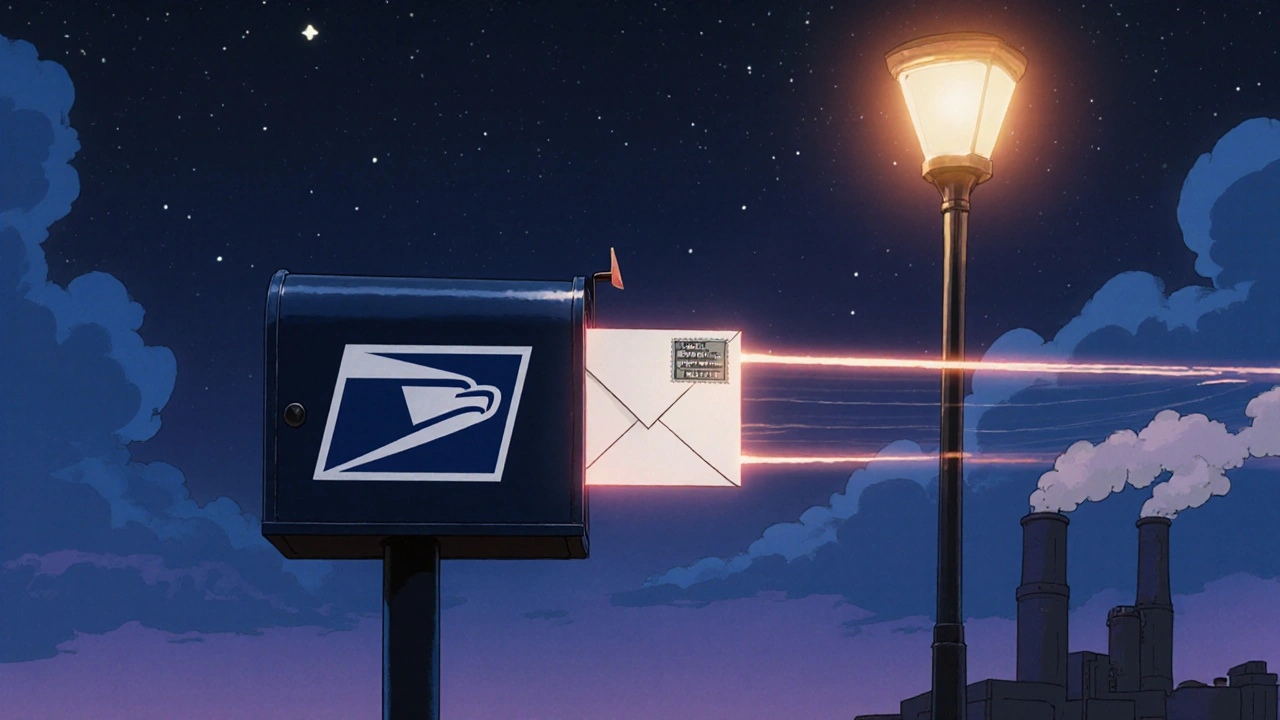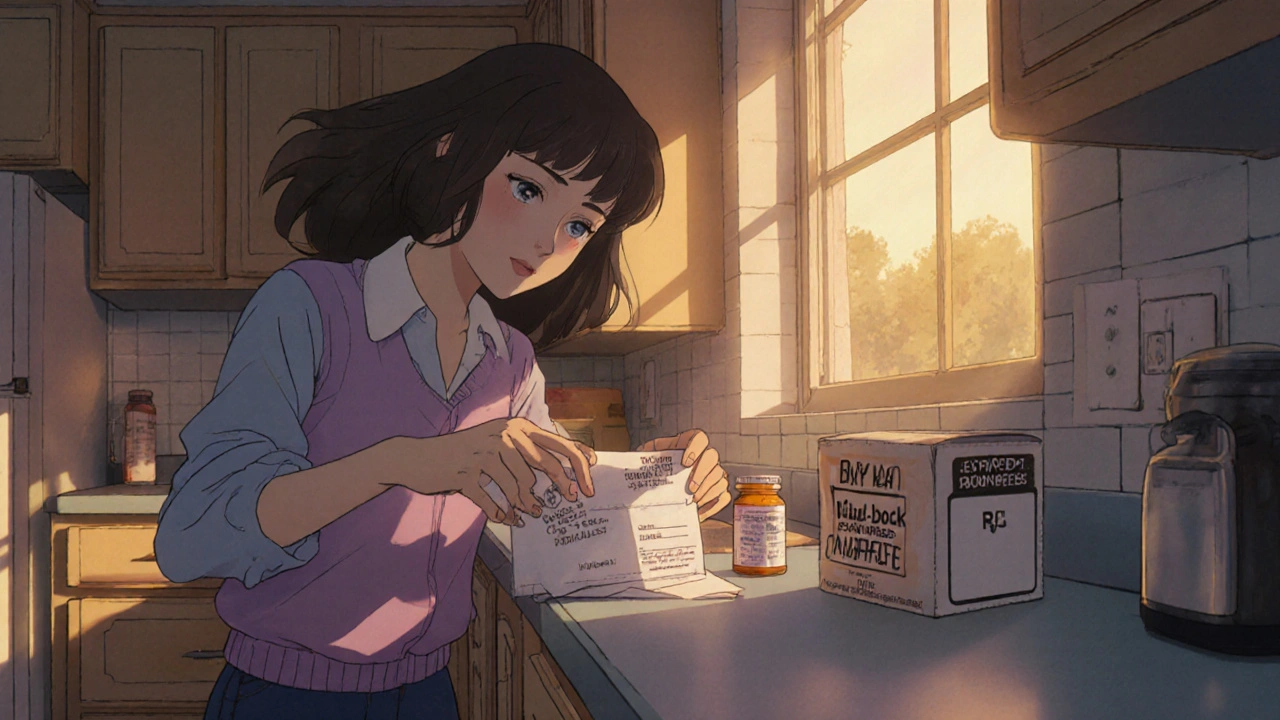Every year, millions of unused or expired medications end up in bathroom cabinets, kitchen drawers, or worse-flushed down the toilet or tossed in the trash. It’s not just messy; it’s dangerous. Medications in landfills can leach into groundwater. Flushed pills pollute rivers and harm aquatic life. And left in plain sight, they become easy targets for theft, misuse, or accidental poisoning-especially for kids or teens. The good news? There’s a simple, safe, and legal way to get rid of them: prepaid drug mail-back envelopes.
What Are Prepaid Drug Mail-Back Envelopes?
These are pre-addressed, postage-paid envelopes designed to let you send your old or unused medications directly to a secure disposal facility. No trips to the pharmacy. No waiting for a take-back day. You just fill, seal, and drop it in the mailbox. The FDA calls them “one of the best ways to safely dispose of unused or expired prescription and nonprescription medicines.” They’re approved by the DEA and follow strict federal guidelines under the Secure and Responsible Drug Disposal Act of 2010.The envelopes are tamper-evident, meaning once you seal them, you can tell if someone tried to open them. Inside, your meds are kept private and secure until they’re destroyed-usually by high-temperature incineration at DEA-registered facilities. No landfill. No recycling bin. No chance of someone digging through your trash.
What Can You Put in These Envelopes?
Not everything goes in. These envelopes are made for pills, liquids, creams, and patches-but not everything else. Here’s what’s accepted:- Expired or unused prescription medications
- Over-the-counter drugs like pain relievers, cold medicine, or antacids
- Pet medications
- Medication samples from doctors
- Liquids and lotions (up to 4 ounces total)
- Controlled substances (Schedule II-V)-including opioids, painkillers, and ADHD meds
And here’s what stays out:
- Needles, syringes, or sharps (use a dedicated sharps container)
- Aerosols, inhalers, or e-cigarettes (they need special handling)
- Illicit drugs or Schedule I substances
- Thermometers, bandages, or non-medical items
- Business-generated pharmaceutical waste (for pharmacies or clinics only)
Most envelopes allow up to 8 ounces of medication total-about the size of a small medicine bottle. If you have a lot, you can order multiple envelopes. Some providers even offer bulk packs for families or caregivers managing multiple prescriptions.
How to Use a Mail-Back Envelope
It’s that simple. No training needed. Just follow these four steps:- Order or pick up-Get your envelope from a pharmacy, online retailer, or a free program like the upcoming Opioid Analgesic REMS Mail-Back Program.
- Fill it-Take out the pills, liquids, or patches. You don’t need to remove them from blister packs or bottles, but scratch out your name, address, and prescription number on the label first. This protects your privacy.
- Seal it-Close the envelope completely. Some brands include special orange “Keep Safe” tape-use it. Once sealed, don’t reopen it.
- Mail it-Drop it in any U.S. Postal Service mailbox. Don’t take it to a pharmacy, police station, or hospital. Those places don’t accept filled envelopes.
Some services let you track your envelope online. You’ll see when it was mailed, when it arrived at the disposal site, and when it was destroyed. It’s like a digital receipt that your meds are gone for good.

Where to Get Them
You can find these envelopes in a few places:- Pharmacies-Many local pharmacies now stock them for free, especially those partnered with the DEA or state take-back programs. Call ahead to ask.
- Online-Sites like MailBackMeds.com, Stericycle’s Seal&Send, and American Rx Group sell them in packs of 3, 50, or even 250. Prices range from $5 to $15 per envelope, depending on volume.
- Free government programs-Starting March 31, 2025, pharmacies that dispense opioid painkillers will be required to offer free mail-back envelopes to patients. This is part of the new Opioid Analgesic REMS program.
- Community programs-Some cities, counties, or nonprofits give them out for free during health fairs or drug awareness events. Check your local health department website.
If you’re unsure where to start, the Drug Takeback Solutions Foundation has a searchable map showing free mail-back locations and participating pharmacies across the U.S.
Why This Is Better Than Other Methods
You might be thinking: “Can’t I just throw them in the trash?” Or “I flush them because it’s easier.” Here’s why neither works:- Trash disposal-Medications in the garbage can be found by curious kids, pets, or people looking for drugs. Studies show 1 in 5 teens have taken prescription meds from a family member’s medicine cabinet.
- Flushing-Even “flushable” labels on old bottles are misleading. Water treatment plants can’t remove all drug chemicals. Traces of antidepressants, antibiotics, and hormones have been found in rivers and drinking water supplies.
- Take-back events-These happen only twice a year. If you miss one, you’re stuck waiting months.
Mail-back envelopes fix all of that. You can dispose of meds anytime. No crowds. No waiting. No risk of exposure. And because the materials are incinerated with energy recovery, some companies even turn your old pills into electricity.
Who Benefits the Most?
This isn’t just for seniors or people with chronic illness. Everyone wins:- Families-Keep kids and teens safe from accidental or intentional misuse.
- Seniors-Easier than driving to a drop-off site, especially if mobility is an issue.
- Caregivers-Managing meds for multiple people? Order a 50-pack and handle disposal in one go.
- Environment-Prevents water contamination and reduces landfill pollution.
- Communities-Fewer drugs on the street means less addiction and crime.
Pharmacies and health systems benefit too. Offering mail-back envelopes shows they care about public safety and sustainability. It builds trust.

What’s Changing in 2025?
A major shift is coming. On March 31, 2025, the Opioid Analgesic REMS Mail-Back Envelope Program launches. This is a federal requirement for manufacturers of opioid painkillers. If you get a prescription for oxycodone, hydrocodone, or any other opioid analgesic, your pharmacy must offer you a free mail-back envelope at the time of pickup.This isn’t optional. It’s the law. And it’s a big step toward reducing opioid misuse at the source. The goal? Cut down on leftover pills that end up in the wrong hands.
Some states are already ahead of the curve. California’s Med Take Back program offers special envelopes for inhalers and injectable meds. Other states are expected to follow.
Common Mistakes to Avoid
Even though the process is simple, people still mess up:- Forgetting to black out personal info-Your name and Rx number are on the bottle. Scratch it out before putting meds in the envelope.
- Trying to mail sharps or inhalers-These need separate disposal. Don’t risk contamination or rejection.
- Delivering the envelope to a pharmacy-They can’t accept filled envelopes. Only the USPS can pick them up.
- Waiting until the bottle is full-If you’ve got a few expired pills, don’t wait months. Dispose of them now.
- Assuming all envelopes are the same-Check the provider’s list of accepted items. Some have different weight limits or rules.
Pro tip: Keep a small box in your medicine cabinet labeled “To Be Disposed.” Add expired meds as you find them. Once it’s half-full, order an envelope. Easy.
Final Thoughts
Prepaid drug mail-back envelopes aren’t a magic solution-but they’re the closest thing we have to a perfect disposal method. They’re safe, legal, private, and eco-friendly. They work for anyone, anytime, anywhere in the U.S. And with new federal rules coming in 2025, they’re becoming even more accessible.If you’ve got old pills sitting around, don’t ignore them. Don’t flush them. Don’t toss them. Use a mail-back envelope. It takes five minutes. And it could save a life-yours, your child’s, or someone else’s.

katia dagenais
November 26, 2025 AT 10:11Okay but have you ever tried to get one of these envelopes from a pharmacy? I showed up at three different ones last month and each time they looked at me like I asked for a unicorn. One pharmacist said 'We don't do that here' like I was asking to mail a dead cat. It's 2025, not 1998. Why is this still so hard to access if it's supposedly the gold standard?
Jack Riley
November 27, 2025 AT 13:07It’s not about the envelope. It’s about the cultural rot that lets us hoard psychoactive chemicals like they’re collectible coins. We treat medicine like a vending machine - take, keep, forget, repeat. The envelope is just a Band-Aid on a gunshot wound. We need to stop prescribing opioids like candy and start treating addiction like the public health emergency it is. But no, let’s just mail our problems away.
Jacqueline Aslet
November 27, 2025 AT 20:04While the logistical framework presented herein is undoubtedly pragmatic, one must interrogate the underlying epistemological assumption that individual responsibility alone can rectify systemic pharmaceutical mismanagement. The onus placed upon the layperson to enzymatically disentangle themselves from pharmacological detritus via postal intermediaries is, in essence, a neoliberal performative gesture - a symbolic appeasement to ecological conscience while corporate entities continue their unchecked production cycles. The envelope, therefore, is less a solution than a rhetorical artifact.
Caroline Marchetta
November 28, 2025 AT 10:12Oh wow, so now I’m supposed to be responsible for my own pills? Like, what’s next? Do I also have to alphabetize my expired Tylenol and write it a heartfelt apology letter? I mean, I’m sure the pharmaceutical companies are just *so* heartbroken that people might accidentally take their grandma’s painkillers. But hey, at least we can mail it away and feel like we did something. *sips tea dramatically*
Valérie Siébert
November 29, 2025 AT 09:43YESSSS this is life changing!! I just got my 5-pack from MailBackMeds and I’m already on envelope #3. My mom’s meds, my dad’s anxiety pills, my own sleep aids - all gone. No more mystery bottles in the cabinet. I even made a little checklist and stuck it on the fridge. It’s like a tiny win for mental peace. Also, the tracking feature? Chef’s kiss. 🙌
Josh Gonzales
November 30, 2025 AT 08:49Important note: if you're mailing liquid meds, make sure they're in a sealed plastic bag inside the envelope. One guy I know had his whole envelope leak and the postal worker had to quarantine it. Also, don't forget to check if your state has extra rules - some places don't allow certain controlled substances even if the feds say it's okay. Just call the disposal facility first.
Kimberley Chronicle
November 30, 2025 AT 16:30Love this. I’ve been using these for my elderly parents and it’s made such a difference. No more awkward conversations about 'why do you have 12 bottles of oxycodone?' Just pop them in, mail, done. The fact that it’s free under the new 2025 rules? Brilliant. More pharmacies need to proactively offer these - not wait for patients to ask. Simple solutions deserve simple promotion.
Patricia McElhinney
November 30, 2025 AT 21:55This article is dangerously misleading. You say 'no need to remove pills from blister packs' but fail to mention that the FDA explicitly requires all prescription containers to be rendered unidentifiable prior to disposal. You also omit that some states classify these envelopes as 'medical waste' and require special labeling. And why are you promoting private companies like Stericycle? Are they paying you? This is irresponsible. I’ve reported this post to the mods.
Dolapo Eniola
December 1, 2025 AT 11:19Y’all in North America really think mail-back envelopes fix everything? In Nigeria we just burn them in open pits. It’s cheaper, faster, and the smoke keeps the mosquitoes away. You people overthink everything. Just throw it in the fire and move on. Also, why are you so scared of your own medicine? It’s just chemicals. 😎
Rachel Villegas
December 2, 2025 AT 07:54I’ve been using these since 2022. I keep a small bin under my sink labeled 'To Mail' and every time I clean out the cabinet I add to it. Last month I mailed 17 pills, 3 patches, and a bottle of liquid cough syrup. Took 5 minutes. No drama. No guilt. Just done. This is how it should be.